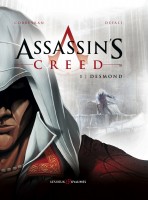As is customary for high-profile video games nowadays, Assassin’s Creed has branched off into other products, in this case the world of the funny books. Despite my pitiful amount of play-time with the series, I am still a huge fan, probably due to the general concept alone; as such it comes to me to give you the Major Spoilers look at the first few books after the jump.
 ASSASSIN’S CREED #1-3
ASSASSIN’S CREED #1-3
Writer: Corbeyran
Artist: Djillali Defali
Colorist: Raphael Hedon (1) & Alexis Sentenac (2,3)
English Translation: Mark McKenzie-Ray
Publisher: Titan Books
Price: $9.99 each
New to Assassin’s Creed? The Assassin’s Creed game series has the player take control of different assassins across time in the ongoing war between the Assassins and the Knights Templar. The twist on this is the main character, Desmond, is actually in the present and is reliving his ancestors’ memories through a device called the Animus. In the first game, it is actually the Templar that have Desmond captured and hooked up to the machine for them to gain insights into the secrets of the Assassins, which is where book 1 starts.
THREE ASSASSINS
Each of the three books is titled for which assassin it will be following: Desmond, Aquilus, and Accipiter. Desmond, being the main character of the series, has already had a majority of his story told, as such his book is a bit weak, but let’s look at some of the details. We open with a failed attempt to see the life of Aquilus as a nigh-fatal wound pulls Desmond out of the simulation and into the sterile labs at Abstergo, the Templar’s company. From here, we go into a bit of how Desmond ended up there, being drugged by a pretty girl he goes home with from the bar, who also happens to be the assistant in the lab, who then turns out to be an Assassin herself and later rescues Desmond from Abstergo. Most of that comes from the games themselves; in fact the entire rescue sequence is how the Assassin’s Creed II starts. The pacing is a bit rough in the first volume, but it gives us enough on the character end to make up for it, and volume’s two and three get much better.
The second book is a story of two betrayals. One against Aquilus, which caused the sequence ending wound from the first book, and one against the Assassins Desmond is now working with. The new team is travelling to a more secure location, and while doing so they have Desmond hooked up to an Animus in the back of the semi. The two stories are designed to parallel each other and it ends up working better than I would have thought. Aquilus’s story is during the Roman Empire circa 259 a.d. and picks up from the devastating betrayal that caused problems in the first book as he is rescued by his cousin Accipiter. From there we follow him as he learns who betrayed them, Senator Vultur. Meanwhile, the modern crew is being harassed by Abstergo mercenaries and cannot figure out how they keep finding them. Once Desmond learns of the Vultur’s betrayal and the meaning of his name, vulture, he is able to identify the betrayer in the group due to his last name also meaning vulture; which, in retrospect, is a rather lame and contrived way of determining the villain. The twin plots work well together, but come to a rather disappointing conclusion.
The Accipiter story ends up being the best of the three, as Accipiter is not an ancestor of Desmond, but of another modern Assassin, Jonathan Hawk. The story gives us the final days of Aquilus as he attempts to confront Senator Vultur and he and his wife are arrested for it. Aquilus manages to catch up in time to see Aquilus cut down, but he saves the Aquilus’s pregnant wife. It’s a decent conclusion to the story, giving us a final ending point for Aquilus and allowing Desmond to relive a bit of a female ancestor to get the last few pieces of the puzzle. The specific artifact the team was looking for is discovered just in time for Hawk to show up as Desmond’s replacement and end the issue on a mild cliffhanger. The story and characters actually hold up well here, save the point where Desmond is viewing an ancestor past the conception of the next generation.
ANCESTORS’ ARTISTRY
I was never impressed by the art in any of the books. Not to say it was bad, but it was never than adequate. Then there were times it truly took a turn for the poor. Lucy looked absolutely crazy in most of the close-ups. There were also a number of times she was quite awkwardly posed from a distance too. None of the other characters have the same number of problems she did, and many of them are in situations where awkward poses would abound, but it is never a problem unless it’s Lucy.
BOTTOM LINE: If You’re a Fan
Despite enjoying it myself due to a vastly unwarranted love of the series, I could not recommend this to anyone who does not like the series. It’s hard to follow, both due to some missing context and due to poor panel/balloon layout and it has some real problems with body work. As far as a rating, the best I can give the Assassin’s Creed comics is 2.5 out of 5 stars, and that is probably being generous due to some serious fanboy-ing.
DID YOU READ THIS ISSUE? RATE IT!
Reader Rating
[ratings]



